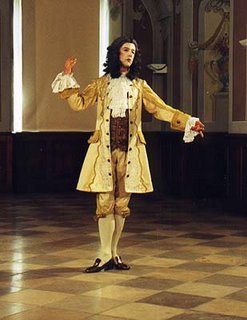
I've recently spent time visiting again with the G Major French Suite of Bach. Even after playing it in concert, the mysteries of its songful Sarabande continue to tickle me and draw me back, back, back to the piano. On certain days it is unearthly -- a perfect, weightless dream. On other days, its shadows and crevices become essential. It gets weighty and human, and I bend it, perhaps, where it shouldn't be bent ...
These different lights seem to change the music every day. It can feel different every time I touch it.
Ah, Bach anguish.
The other day I was lying on my living room floor (I'm not sure why) and there on a very low little bookshelf was Meredith Little and Natalie Jenne's book Dance and the Music of J.S.Bach.
Chapter 7 tracks the "tawdry" history of the Sarabande. From Spanish origins, it arrived in Italy as an exotic and tempestuous dance with fiery variations. Opponents wrote passionately against its lasciviousness.
The French are said to have "tamed" the thing, giving it order and balance. But the two authors spend time considering the teasing passion behind all that balance by citing a recently discovered description written in the 1600's of a solo dancer seducing a crowd with his sarabande:
At first he danced with a totally charming grace, with a serious and circumspect air, with an equal and slow rhythm, and with such a noble, beautiful, free and easy carriage that he had all the majesty of a king, and inspired as much respect as he gave pleasure.
Sometimes he would glide imperceptibly, with no apparent movement of his feet and legs, and seemed to slide rather than step. Sometimes, with the most beautiful timing in the world, he would remain suspended, immobile, and half leaning to the side with one foot in the air; and then, compensating for the rhythmic unit that had gone by, with another more precipitous unit he would almost fly, so rapid was his motion.
Sometimes, for the pleasure of everyone present, he would turn to the right, and sometimes he would turn to the left; and when he reached the very middle of the empty floor, he would pirouette so quickly that the eye could not follow.
Now and then he would let a whole rhythmic unit go by, moving no more than a statue, and then, setting off like an arrow, he would be at the other end of the room before anyone had time to realize that he had departed.
But all this was nothing compared to what was observed when this gallant began to express the emotions of his soul through the motions of his body, and reveal them in his face, his eyes, his steps and all his actions.
Sometimes he would cast languid and passionate glances throughout a slow and languid rhythmic unit; and then, as though weary of being obliging, he would avert his eyes, as if he wished to hide his passion; and, with a more precipitous motion, would snatch away the gift he had tendered.
Now and then he would express anger and spite with an impetuous and turbulent rhythmic unit; and then, evoking a sweeter passion by more moderate motions, he would sigh, swoon, let his eyes wander languidly; and certain sinuous movements of the arms and body, nonchalant, disjointed and passionate, made him appear so admirable and so charming that throughout this enchanting dance he won as many hearts as he attracted spectators.
No comments:
Post a Comment